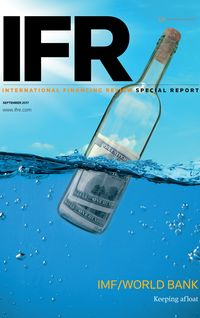Egypt has visited the capital markets twice this year. The success of the deals is down to an IMF loan at the end of last year which helped put the country back on a path for economic success.
In the 13th century BC, the Egyptian pharaoh Ramesses II had a remarkably direct and pragmatic approach to financing. When in doubt, his soldiers simply invaded neighbouring countries. The long reign of the country’s greatest pharaoh was characterised by his not-infrequent military adventures across what is now the Middle East and south into modern Sudan.
Feeling similar pressures on the exchequer, though favouring a more sensitive approach to global Machtpolitik, the Arab Republic of Egypt has financed itself through the capital markets with two deals this year that have helped settle the country back into the straight and narrow.
At the end of January, Egypt followed in the slipstream of Argentina and Turkey to tap international demand for emerging market debt, with a US$4bn 144A/Reg S deal. It made sense at the time, said bankers, with conditions for emerging market names better than they had been for the past couple of years.
What no one predicted, however, was the appetite for the paper. A target size of US$2.5bn was quickly upsized to US$4bn after the three-tranche deal garnered US$13.5bn in orders. In the end, Egypt printed US$1.75bn of five-year paper at 6.125%; US$1bn of 10-year notes at 7.5%; and US$1.25bn of 30-year paper at 8.5%.
More to the point, the paper went to the kind of investors that issuers really want. It was primarily bought by emerging market real money accounts, along with some long-only hedge funds. A sign of the quality too is that more than half of demand came from the US across all three tranches.
“The US remains a key investor base for all liquid and large issues – with around 50% of the book on the last Egypt transactions,” said Hani Deaibes, JP Morgan’s head of DCM for the Gulf region, who worked on both bond deals.
What undeniably underpinned investor demand for the bond sale was a US$12bn loan from the IMF that was given to support the government’s home-grown comprehensive economic reform plan.
“The programme is by the Egyptian government, for the Egyptian people, and to help the Egyptian economy,” was how it was described by IMF managing director Christine Lagarde as she announced it in November last year.
Tied to a raft of reform measures, such as currency liberalisation, tax hikes and a focus on the public sector wage bill, the loan was intended to kick-start a reform programme that would revive Egypt’s growth prospects. The bond issue hit the market at exactly the right time.
“The first deal in January was on a back of significant reforms and the IMF deal, which was important,” said Rajiv Shah, head of debt capital markets, Middle East, Turkey and Africa, for BNP Paribas, also on both of Egypt’s bond deals. “We saw a bold move for the government to get back on track.”
Certainly, it was questions of fiscal reform and details of the IMF loan that dominated discussions on the roadshow.
Currency adjustment
The most significant move that the government made was to abandon the Egyptian pound’s currency peg to the US dollar. It had blindly held on to an exchange rate of 8.80 to the US dollar for decades. By mid-September, it was trading at 17.60.
“Egypt had run an overvalued currency peg for a long time,” said Stuart Culverhouse, global head of research at London-based brokerage Exotix. “Devaluation was part of the IMF programme.”
After an initial slide, the currency has since found a natural level and traded relatively steadily since March.
The IMF loan was exactly what was needed to get the bond away. “It was a rubber stamp that gave the investors some comfort,” said one banker.
But the loan’s importance lies in the fact that Egypt has paid more than lip service to its terms and that the government has engaged fully with the IMF recommendations.
“Egypt’s new budget and lower electricity and fuel subsidies demonstrate a continued commitment to fiscal consolidation and economic reform, backed by the country’s IMF programme,” said Toby Iles, director of sovereigns at Fitch in Hong Kong.
An economy does not turn on a sixpence and most economists share the view of Ahmed Shams El Din, head of research at EFG Hermes, who said that “we will see the fruits of the reforms next fiscal year”.
But the economic reforms are already beginning to pay off. An increase in foreign borrowing and direct investment helped drive Egypt’s economy up 2.6 percentage points to year-on-year growth of 4.9% in the fourth quarter of its 2016–2017 fiscal year, the finance ministry announced at the end of August. At the same time, the government announced that the budget deficit had narrowed to 9.5% of GDP, down from 11.5% a year earlier.
Shoots of recovery helped the sovereign when it came to the capital markets for a second time at the end of May with another supersized bond – a tap of the previous issue.
“Global markets had performed and all three tranches had performed well in secondary,” said one banker close to the deal, explaining why Egypt went for a tap rather than a new issue.
Again, demand was high. It hit US$11bn, which finance minister Amr Al-Garhy pointed out was the greatest ever for any emerging market credit when reoffering its notes. While bankers rarely take anything for granted, one of those on the deal explained that there is an advantage in holding roadshows a couple of times a year.
“It means you can provide an update to key accounts,” he said. “There is not a change in tone, but you can say on the first roadshow: ‘we plan to do A, B and C’. The next time you can say: ‘we have done A and we have a concrete plan for B’. Investors appreciate that type of regular update a great deal,” he said.
There is no doubting how much reforms and economic updates brought the coupons down. On the 10-year alone, it tightened in 85bp. Egypt tapped the five-year for US$750m at 5.45%, the 10-year for US$1bn at 6.65% and the 30-year at US$1.25bn for 7.95%. This took the nominal outstanding on the 2022s to US$2.5bn, the 2027s to US$2bn and the 2047s to US$2.5bn.
The question now is what next for the sovereign. There was talk earlier in the year about further issuance, but that seems to have been overblown. Mutterings of US dollar sukuk issuance, or even issues in renminbi or yen, are said to be wishful thinking. This is not to say that another deal is not going to happen – bankers inevitably comment that further issuance is subject to market conditions – but the significant point is that Egypt could come again.
In the immediate term, the government’s focus is going to be on pushing through with the economic reforms that it has already begun. No one is in any doubt of how major a job this is.
“Narrowing the fiscal deficit supports Egypt’s sovereign credit profile, but significantly reducing the public debt ratio is a multi-year task,” said Fitch’s Iles.
But the government’s commitment is unwavering. Indeed, the only possible fly in the ointment is the general election which is expected to be held in early 2018. But even this is not expected to derail progress.
“Election risk has been priced in. Reform is no longer a matter of choice” said EFG Hermes’ Shams El Din.
To see the digital version of this report, please click here.
To purchase printed copies or a PDF of this report, please email gloria.balbastro@tr.com



